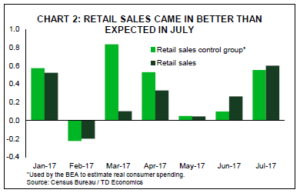FINANCIAL NEWS HIGHLIGHTS OF THE WEEK
- A relatively good week for economic data was overshadowed by geopolitical events. Volatility spiked late in the week, the Dow suffered its largest one day loss since May on Thursday, and the 10-Year Treasury rallied to 2.17%.
- Investor nervousness is understandable, but there is little reason to doubt the ongoing economic expansion. U.S. retail sales rose by a robust 0.6% in July and were upwardly revised in June.
- Minutes from the FOMC’s July 26 rate announcement showed a Fed looking for proof that inflation is moving toward target, and agreeing that balance sheet reduction should begin soon (likely in September).
Good Data Overwhelmed By Geopolitical Concerns
A relatively good week for economic data was overshadowed by geopolitical events and concerns about the economic leadership within the Trump administration. On Thursday, volatility spiked, equites saw their biggest declines since May (the Dow down 1.2%) and Treasuries rallied (U.S. 10-year fell to 2.19%) as investors sought the protection of safe assets.
The understandable nervousness among investors notwithstanding, there is little reason to doubt the ongoing economic expansion. Retail sales rose by a robust 0.6% in July and were upwardly revised in June. The details were encouraging with broad-based strength across categories. Given consistently strong job growth, accelerating wage growth and benign inflation, consumer spending should remain healthy over the second half of the year. We expect personal spending to rise by 3.0% in the third quarter. With additional support from business spending, real GDP should rise by about as much. 
On the topic of inflation, the minutes from the Federal Open Market Committee’s July 25-26 meeting gave additional detail on how monetary policymakers are responding to its recent misses. The dilemma for policymakers is how to explain the continued downward drift in inflation in spite of ongoing tightening in the labor market. The minutes offered several possible explanations: a weakened relationship between resource slack and inflation, a lower natural rate of unemployment, greater lags in the relationship between economic tightening and inflation, and restraints on pricing power due to technology and globalization.
Overall, their faith is being tested, but it has not been lost. “Most participants thought that the [Phillips curve] framework remained valid” and still believe that inflation will return to target over the medium term. At a minimum however, they will need to see some proof that inflation is moving toward target in order to continue to push up policy rates.
 The one area where the Fed was in general agreement was in the need to begin normalizing the balance sheet. While there was little new on this front in the discussions, the minutes confirmed previous announcements and statements by several Fed members. Importantly, the Fed does not see balance sheet normalization as substituting for increases in the federal funds rate, but rather hopes to proceed as inconspicuously as possible. Nonetheless, just as asset purchases helped to bring down yields, the unwinding of purchases is likely to put modest upward pressure on longer-term yields. Our forecast for Treasury yields over the next two years imbeds a 10 to 20 basis point rise stemming directly from balance sheet reduction.
The one area where the Fed was in general agreement was in the need to begin normalizing the balance sheet. While there was little new on this front in the discussions, the minutes confirmed previous announcements and statements by several Fed members. Importantly, the Fed does not see balance sheet normalization as substituting for increases in the federal funds rate, but rather hopes to proceed as inconspicuously as possible. Nonetheless, just as asset purchases helped to bring down yields, the unwinding of purchases is likely to put modest upward pressure on longer-term yields. Our forecast for Treasury yields over the next two years imbeds a 10 to 20 basis point rise stemming directly from balance sheet reduction.
All of this assumes that the political situation in Washington remains stable. September will be a busy month for Congress, who has to pass an increase in the statutory debt ceiling and find a way to continue funding the government and avoid a shutdown. At the same time the administration will continue to push for personal and corporate tax reform. If Congress fails to reach accord on either the debt ceiling or government funding, we would expect increased volatility and additional losses in equity markets that still appear priced for perfection. As it has in the past, the financial and political damage would likely move politicians to quickly fall into line.
James Marple, Senior Economist
This report is provided by TD Economics. It is for informational and educational purposes only as of the date of writing, and may not be appropriate for other purposes. The views and opinions expressed may change at any time based on market or other conditions and may not come to pass. This material is not intended to be relied upon as investment advice or recommendations, does not constitute a solicitation to buy or sell securities and should not be considered specific legal, investment or tax advice. The report does not provide material information about the business and affairs of TD Bank Group and the members of TD Economics are not spokespersons for TD Bank Group with respect to its business and affairs. The information contained in this report has been drawn from sources believed to be reliable, but is not guaranteed to be accurate or complete. This report contains economic analysis and views, including about future economic and financial markets performance. These are based on certain assumptions and other factors, and are subject to inherent risks and uncertainties. The actual outcome may be materially different. The Toronto-Dominion Bank and its affiliates and related entities that comprise the TD Bank Group are not liable for any errors or omissions in the information, analysis or views contained in this report, or for any loss or damage suffered.



